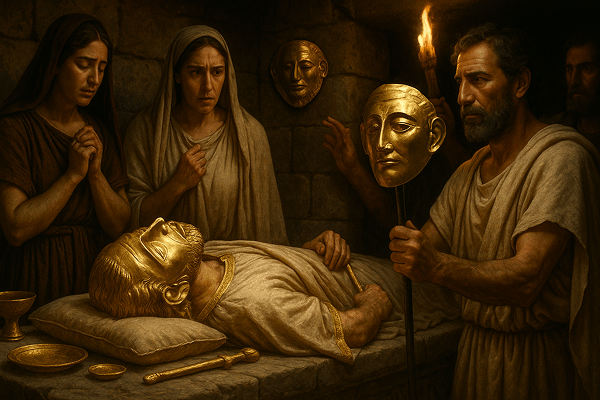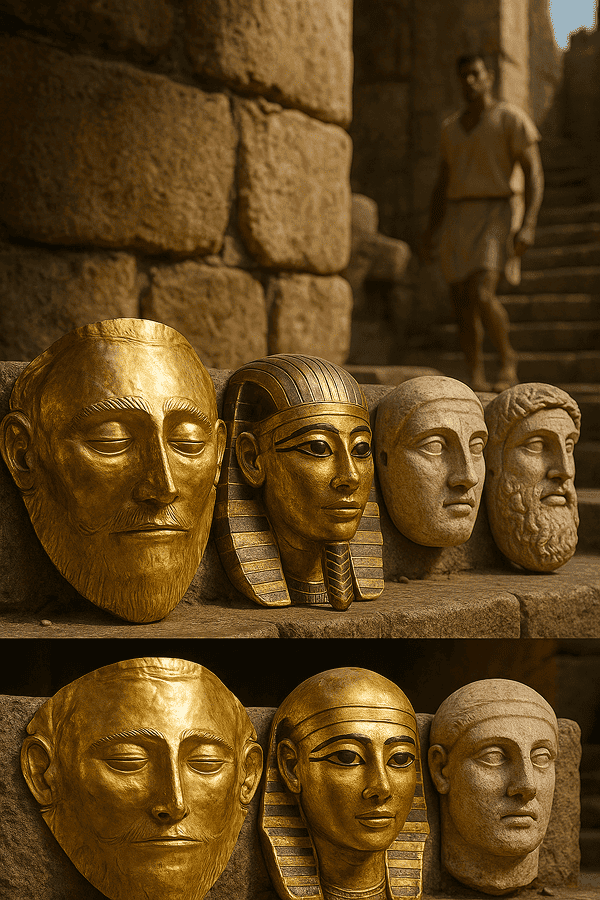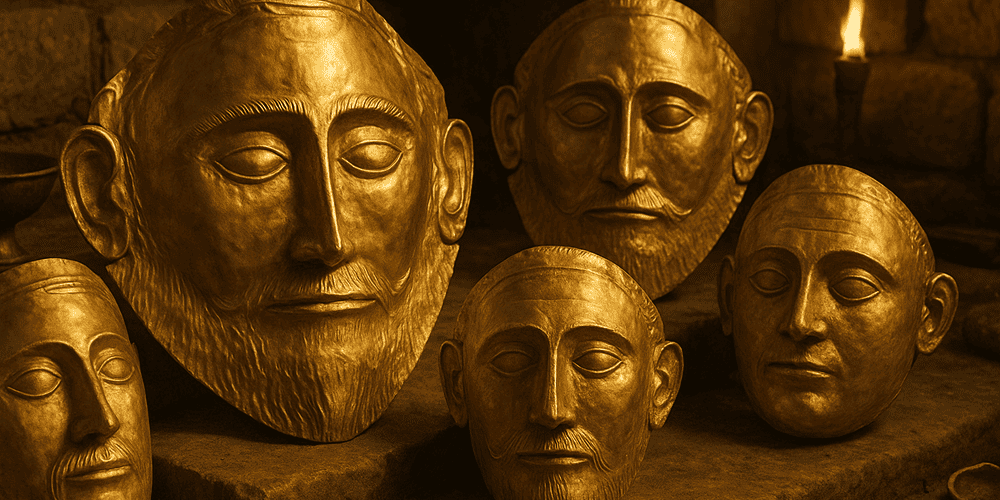Greek Funeral Masks are among the most striking and historically significant artifacts from ancient Greece, embodying the intersection of art, ritual, and belief about the afterlife. Most famously associated with the Mycenaean civilization (circa 1600–1100 BCE), these masks are typically crafted from thin sheets of gold, hammered into the likeness of a human face. The best-known examples, such as the so-called “Mask of Agamemnon,” feature stylized facial features — almond-shaped eyes, carefully rendered noses, and expressive mouths — often with incised details for hair and beard. Greek Funeral Masks were designed to be placed over the face of the deceased, signifying both honor and protection for their journey into the next world. Found primarily in royal or elite burials within the Mycenaean heartland (notably Mycenae and Tiryns), these masks are a testament to the sophistication and spiritual concerns of Bronze Age Greece.
Historical Origins of Greek Funeral Masks
The tradition of Greek Funeral Masks has its roots in the funerary practices of the Mycenaean civilization, which flourished in the southern Greek mainland during the Late Bronze Age. The Greek word for mask, “prosopon” (πρόσωπον), originally meant “face,” reflecting both the literal and symbolic function of these objects. The earliest masks, dating from the 16th century BCE, were found in shaft graves at Mycenae and were almost exclusively made for men of high status, likely kings or nobles. The historical context for their development includes the emergence of complex social hierarchies, elaborate burial customs, and the cult of heroic ancestors. Over time, the design of funeral masks evolved — from simple gold sheets with minimal detail to highly naturalistic representations, as seen in later Mycenaean graves. Archaeological discoveries by Heinrich Schliemann in the 19th century brought these artifacts to global attention, with the Mask of Agamemnon becoming an icon of ancient Greek art. The tradition faded with the decline of the Mycenaean world, but the concept of the funerary mask persisted in various forms across the Greek world and later influenced Roman and Byzantine practices. For those interested in the broader context, Greek Ritual Masks also offer fascinating insight into the role of masks in ancient Greek society.
Cultural Significance and Symbolism of Greek Funeral Masks
In their native culture, Greek Funeral Masks were far more than mere funerary ornaments; they were imbued with deep symbolic and religious meaning. The mask served as both a final portrait and a spiritual safeguard, ensuring that the deceased would be recognized and honored in the afterlife. Many scholars believe these masks embodied the heroic ideal, presenting the dead as ageless, serene, and dignified — worthy of remembrance and veneration. In mythological terms, the mask could function as a conduit for the soul, helping to mediate between the worlds of the living and the dead. Funerary rituals often included prayers, offerings, and processions, with the mask reinforcing the status and identity of the deceased. Legends and epics, such as those surrounding Agamemnon and the heroes of the Trojan War, contributed to the aura of the mask as a symbol of power, continuity, and immortality. Socially, the masks reflected the elite status of the wearer and the collective memory of the community.

Materials and Craft Techniques of Greek Funeral Masks
Greek Funeral Masks are most commonly made from hammered gold, a material chosen for its association with purity, immortality, and divine favor. The process began with a thin sheet of gold, which artisans shaped over a wooden or stone mold using hammers and punches. Details such as eyes, mouth, hair, and beard were incised or repoussé (hammered from the reverse side) to create a lifelike or idealized visage. Some masks included holes at the edges for tying or attaching them to the face or shroud. Although gold is the most renowned material, there is evidence that earlier or less affluent burials may have used bronze, leather, or even linen masks, now lost to time. Regional differences in technique are evident in the artistry of Mycenae, Tiryns, and other sites, with some masks being more abstract and others more naturalistic. The choice of gold, the stylization of features, and the inclusion of specific decorative elements — such as spiral motifs or geometric patterns — reflect both aesthetic values and religious beliefs about the afterlife.
Functions and Uses of Greek Funeral Masks
The primary function of Greek Funeral Masks was ritual and ceremonial, intended to honor and protect the deceased during burial and in the afterlife. Placed directly over the face of the dead, the mask was thought to preserve the individual’s identity and status, ensuring their memory endured among the living and the gods. There is little evidence for theatrical or festival use of these masks in ancient Greece, as their role was confined to the mortuary context. However, the practice of creating a final likeness for the dead influenced later traditions, such as Roman death masks and Byzantine funerary portraits. Over time, as burial practices evolved and cremation became more common in Greece, the use of funeral masks declined. Today, Greek Funeral Masks are studied, displayed in museums, and occasionally recreated for educational or commemorative purposes.
Regional Variations in Greek Funeral Masks
While the heartland of Greek Funeral Mask tradition was Mycenae and its neighboring centers, similar practices can be traced in other Aegean and Mediterranean cultures. Mycenaean masks are distinguished by their use of gold and their stylized male faces, but related traditions can be seen in Crete (in the Minoan civilization) and even in the ancient Near East. Some regions favored more abstract masks, while others pursued greater naturalism, possibly reflecting local beliefs about death and the afterlife. Comparisons with funerary masks from Egypt, Etruria, or Persia highlight both the uniqueness and the shared symbolism of masking the dead. Each region’s approach was shaped by its own religious, artistic, and social context.

Famous Examples and Collections of Greek Funeral Masks
The most famous Greek Funeral Mask is the Mask of Agamemnon, discovered in Grave Circle A at Mycenae and now displayed in the National Archaeological Museum of Athens. Other notable examples include the gold masks from Tiryns, Dendra, and other Mycenaean sites, each bearing unique features and stylistic variations. Numerous museums around the world hold Greek funeral masks or related artifacts, including the British Museum, the Louvre, and the Metropolitan Museum of Art. These collections often feature not only the masks themselves but also associated grave goods, weapons, and jewelry, providing a broader context for their use. Some private collections and digital archives, such as toddmasks.com, offer virtual access to rare masks and expert commentary.
Influence of Greek Funeral Masks on Art and Culture
Greek Funeral Masks have had a lasting impact on Western art, archaeology, and cultural imagination. Their discovery in the 19th century inspired a wave of fascination with ancient Greece, influencing painters, sculptors, and writers. The motif of the golden mask has appeared in literature, opera, film, and even modern fashion, symbolizing mystery, heroism, and the allure of the ancient past. In museum exhibitions and educational programs, Greek Funeral Masks serve as powerful tools for teaching about Bronze Age society, burial customs, and artistic achievement. Their presence in global culture underscores the enduring legacy of Greek art and its role in shaping ideas about death, memory, and identity.
Contemporary Status and Preservation of Greek Funeral Mask Traditions
Today, the tradition of Greek Funeral Masks is preserved primarily through archaeological research, museum curation, and public education. Modern artisans and scholars sometimes create replicas for study or display, using historical techniques and materials. Museums in Greece and worldwide offer exhibitions, lectures, and digital resources to share the history and meaning of these masks with new audiences. University programs and masterclasses may include mask-making workshops or interdisciplinary studies on ancient funerary art. Online resources like toddmasks.com help make this heritage accessible to a global audience, connecting enthusiasts, students, and researchers. While the original ritual function of these masks has vanished, their artistic and symbolic power continues to inspire.
Collecting and Acquiring Greek Funeral Masks
The market for authentic Greek Funeral Masks is extremely limited, as most known examples are held by museums or protected as national treasures. High-quality replicas and educational models are available from specialized workshops, galleries, and museum shops. Collectors interested in Greek funerary art should seek expert authentication, respect international laws, and support ethical sources. Prices for replicas or related artifacts vary widely depending on craftsmanship, materials, and provenance. Toddmasks.com provides guidance on identifying genuine works, understanding their significance, and collecting responsibly. Ethical collecting ensures respect for the cultural, historical, and spiritual value of these masterpieces.
